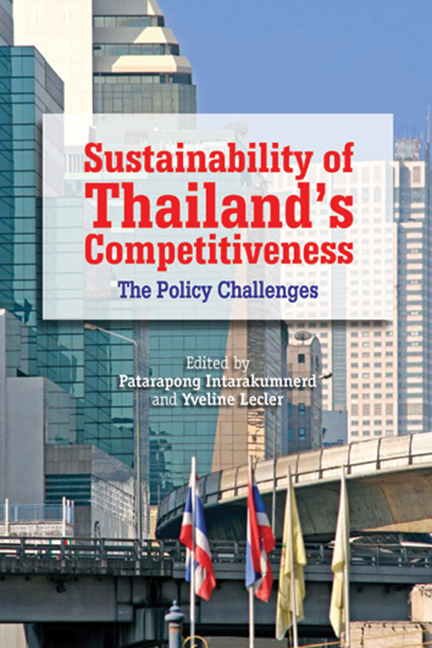Book contents
- Frontmatter
- Contents
- Preface
- Abbreviations
- Contributors
- Introduction
- Part I Thailand's Industrial Development: General Views
- Part II The Roles of Institutions: Clusters and Industrial Estates
- 4 Industrial Restructuring Policies in Thailand: Japanese or American Approach
- 5 The Role of Industrial Estates in Thailand's Industrialization, New Challenges for the Future
- Part III Firms and Government New Initiatives: The Industry Analysis
- Index
5 - The Role of Industrial Estates in Thailand's Industrialization, New Challenges for the Future
from Part II - The Roles of Institutions: Clusters and Industrial Estates
Published online by Cambridge University Press: 21 October 2015
- Frontmatter
- Contents
- Preface
- Abbreviations
- Contributors
- Introduction
- Part I Thailand's Industrial Development: General Views
- Part II The Roles of Institutions: Clusters and Industrial Estates
- 4 Industrial Restructuring Policies in Thailand: Japanese or American Approach
- 5 The Role of Industrial Estates in Thailand's Industrialization, New Challenges for the Future
- Part III Firms and Government New Initiatives: The Industry Analysis
- Index
Summary
The rapid industrialization in Thailand has strongly relied on the capacity to allocate land resources for industries, and provide high-quality facilities and services in industrial sites. Among these sites, as already pointed out in Chapter 1, Industrial Estates (IEs) have played a key role in shaping Thailand's industrialization. Developed after 1972, together with major transportation and communication infrastructure, they have contributed to fostering growth in Thailand by attracting a large share of FDI and multinational companies while preserving the country from heavy pollution and reducing unwanted industrial “sprawl”.
This development has been facing two major challenges briefly mentioned in Chapter 4. The first challenge is the growing regional imbalance in the manufacturing industry, which causes an overconcentration of firms in the region of the national capital, a problem shared by many Asian countries, but particularly worrying in Thailand. The second challenge is the necessity to upgrade the Thai manufacturing industry by focusing on local capacity building and innovation rather than passive technological learning from foreign firms. In the 1980s, IE development was fully undertaken by private developers, under the strict regulations and guidance of the Industrial Estate Authority of Thailand (IEAT). As a result, services and facilities in IEs were gradually improved to meet the demands of multinational firms, to the extent of transforming some estates into virtual “industrial cities”. The present chapter describes this evolution and examines whether it is consistent with the urgent need to restore the regional imbalance and improve local input in the manufacturing sector.
In the first section we describe briefly the distinctive features of Thai IEs. Then we examine the development of the existing IE network, in line with the regional development policy. The third section deals with the role of private involvement in IE development, and its effects on the supply of services and facilities. Finally, we examine to what extent the existing IE framework could be used as a basis for ongoing innovation and cluster-based policies.
- Type
- Chapter
- Information
- Sustainability of Thailand's CompetitivenessThe Policy Challenges, pp. 174 - 206Publisher: ISEAS–Yusof Ishak InstitutePrint publication year: 2010



